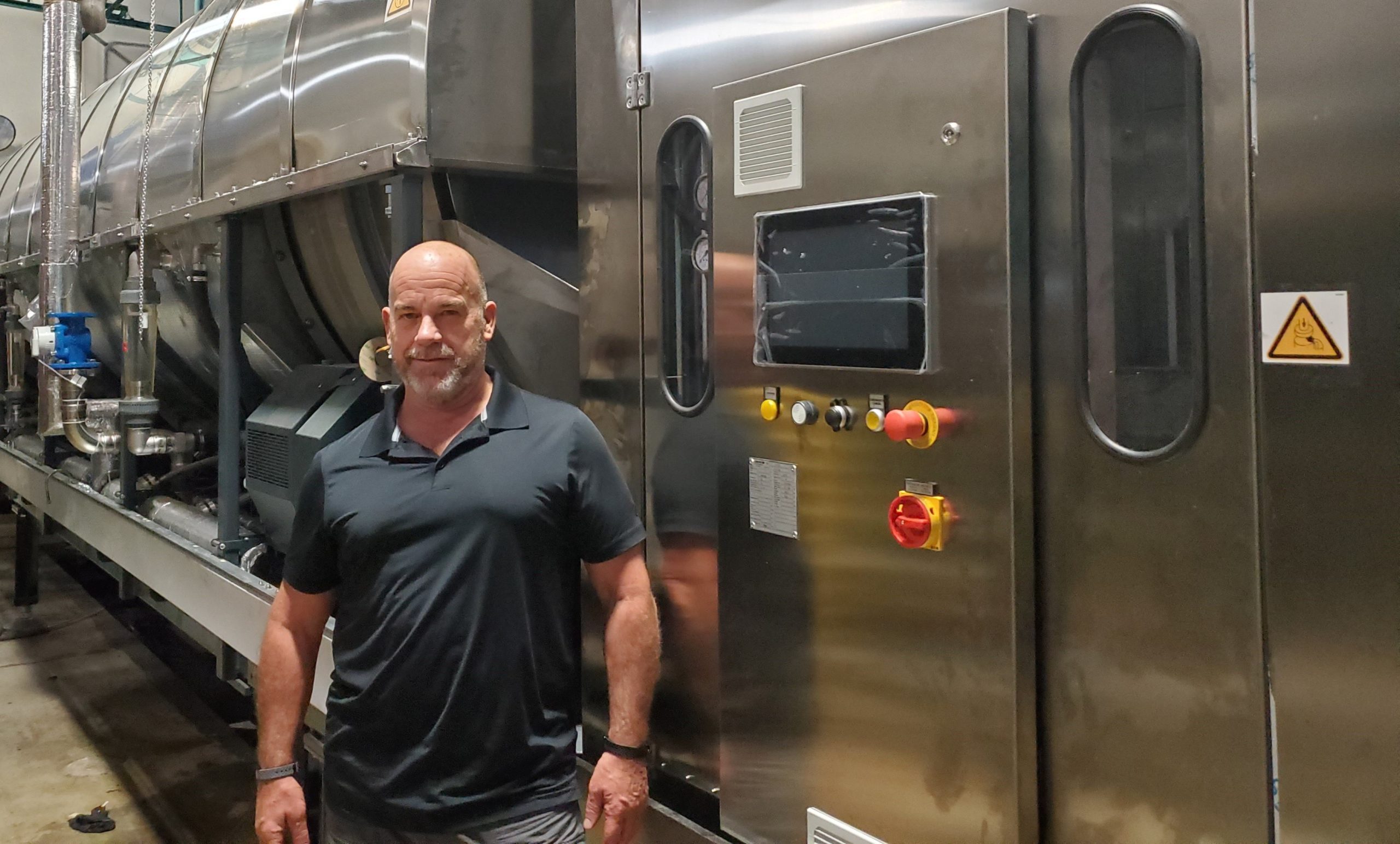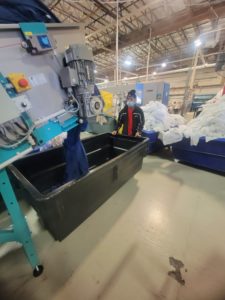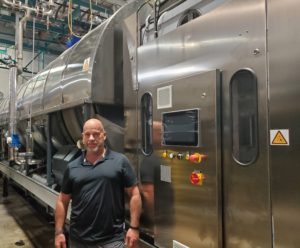
Rick Taft will be the first to admit he’s not the type who does things in a conventional manner. The owner of Textile Care Services (TCS), a commercial healthcare laundry operation with a longtime presence in Utah on Salt Lake City’s south side, had an important decision to make a year ago at the start of the COVID-19 pandemic. He’s glad he pushed forward to install new LAVATEC equipment that has since triggered a series of successful events.
Last fall, TCS was awarded a five-year contract by the University of Utah to handle six million pounds of linen annually. In the first three months of 2021, it’s been a whirlwind of activity. Taft converted a large healthcare Customer Owned Goods (COG) customer to a rental agreement of approximately four million pounds annually. The deal took effect in mid-February, two weeks after he closed a $5.5 million real estate transaction on his facility’s property.
Taft has since purchased 350 new hampers to handle the new business, and is in the process of adding bar codes to all of their 2,500 hampers to more efficiently track locations. This is on top of other major purchases, including two new trucks for his fleet to service rural hospitals and other facilities within a 75-mile radius of Salt Lake City. He also bought a new OLMA folder, a new auto-bagger to improve productivity and reduce touch points on the linen they deliver to the hospitals, and a new air compressor system with a high-efficiency rating.
Taft linked these investments to the new business wins that resulted from his decision to move ahead with installation of the Lavatec equipment. The acquisition included a new press and tunnel system, new gas dryers, a press discharge conveyor and discharge conveyor system, and a two-tiered shuttle system. He’s projecting laundry volume to increase from 9 million to 15 pounds this year, making TCS Utah’s largest laundry operation.

Tunnel dryer operator Anos Lakabung readies a bin to receive linen for one of the new Lavatec gas dryers.
“The addition of the new equipment and the Lavatec tunnel system is beneficial in selling new business. I am not certain we would have been awarded the University of Utah contract had we not done this project,” claimed Taft. “If you could plan such a thing, it would be considered brilliant to schedule a new tunnel installation during a lower volume period. Of course, it was mostly circumstantial due to the COVID crisis. But I did see how it would be advantageous to proceed and that’s why we went ahead with it.”
Taft had ordered the new equipment in early 2020 before the world was turned upside down. Nine days before the governor of Utah issued a Stay-at-Home order on March 27, a 5.7 earthquake struck Salt Lake City. The epicenter was only 15 miles from TCS, but luckily there was no damage to the 56,000 square foot building. The Lavatec equipment had already been delivered, but worldwide travel restrictions due to COVID placed the installation on hold.
“As soon as Lavatec had people available, they reached out to me and I made the decision to move ahead,” recalled Taft. “Being optimistic, I thought the pandemic would be short-lived and also knew TCS would be in a better position once business returned to 100 percent.”
His analysis has paid off handsomely. TCS experienced a 14.6% decrease in volume when comparing last year’s second quarter to 2019, but rebounded in the second half to be down only 3.4% for the year. “Our pound totals were down 27% in April, but the decrease was in the single digits by June and we continued to improve each quarter with some fluctuations,” said Taft. “By December we were ahead of our 2019 numbers due to the new business.”

Many positive changes, including an influx of new business, have occurred at Textile Care Services in Salt Lake City since owner Rick Taft went ahead with the purchase of new press and tunnel system and other Lavatec equipment.
Longevity and real-world applications
Those who know Taft are not surprised with these results. A 37-year industry veteran, his first stint with the company was as general manager from 1992-98. He moved on to National Linen Service and Angelica Textile Services before returning in 2007 and purchasing the company in 2011.
His timeline nearly matches Lavatec’s 30-year history with TCS. Before installation took place last June, a 30-year-old LAVATEC LP571 30-bar press was removed and replaced by a new 132-pound, energy-efficient LAVAPRESS LP572 40-bar hydraulic extraction press.
A new LT60 14-compartment bottom transfer tunnel replaced an older Lavatec tunnel that was later purchased by another company. It is connected to six new LAVATEC TT745, 292-pound capacity natural gas dryers, a press discharge conveyor and discharge conveyor system, and a two-tiered shuttle system. Besides being user-friendly for his operators, the machines give Taft the greater efficiency he was seeking.
“Overall, the equipment has performed well. The new tunnel has water re-use improvements that will reduce our overall water consumption and related sewer usage by 10-15%,” he said.

In the first three months of 2021, Taft completed a real estate deal on his company’s building, made a series of capital investments and hired 25 new employees to handle the increased workload.
“The dryers represent the most improvement. With the infrared technology it has reduced our gas consumption needs by another 25-30%, compared to the 30-year-old Lavatec dryers they replaced. And the 40-bar press reduces moisture in the pressing process that the 30-bar unit it replaced did not. That’s helped us reduce our dryer times by 20%.”
Taft says that’s important due to the shift in the workload TCS has experienced since the COVID crisis took hold one year ago. “We’ve seen an increased request for reuseable items, especially barrier gowns. It’s a trend that continued because many facilities first used disposables soon after the pandemic started,” said Taft.
“Once the inventory was depleted, there were significant shortages at facilities to the point where I heard they were washing disposable items just to have something. We’ve gone above and beyond CDC guidance and industry standards by disinfecting our linen with an EPA registered product called AdvaCare from EcoLab. We continue to send them linen samples quarterly and all have passed as hygienically clean. The other noticeable improvement with the new dryers was the reduction of ragouts due to work or damaged linen.”
To keep the workload flowing and ensure a smooth-running operation, the new equipment is controlled by Lavatec’s osLaundry management system. A platform and technology independent software program, it gives operators instant access to key data. Taft says having the ability to make adjustments in a matter of seconds or minutes instead of waiting for hourly reports is making a big difference.
“The os system is a great tool to monitor real-time results. I often take screenshots of the monitor in the office and share them with the production team when the average hourly turns are in the 28 range – 30 being a perfect world scenario,” he said.
“Employees like to hear they are doing a good job and it’s a useful motivator. It also helps to manage the equipment and you can access it from remote locations. The time and labor savings we are experiencing are a result of being able to react quickly when there is less than ideal performance occurring. It’s also beneficial in reviewing alarms and what specific things are repetitive and need to be addressed with an operator, or from a maintenance standpoint.”
Taft is quick to credit his employees for the success of TCS and their ability to work through the pandemic. Last year he had 70 full-time and 15-20 temporary workers; the growth spurt allowed him to hire 25 new people to begin 2021. He believes bigger things are on the horizon.
“We may not have the most sophisticated plant – we improve it every year – but we are excellent at what we do, and I have the best group of employees that I’ve ever had the privilege to lead and work with. The earthquake sent people scattering out of the plant, yet they returned. They were concerned about COVID but we took precautions and they kept reporting to work.
“The employees factor highly into my goal for TCS to continue providing consistent service with quality products for our long-term healthcare partners. We are at about 90% of our normal volume; I hope to see it at 100% by late July or early August, and perhaps above that level in the fall with the return of elective surgeries. Going forward with the new equipment, we will be able to provide these services while reducing our energy use and carbon footprint, and grow our business in the future.”












